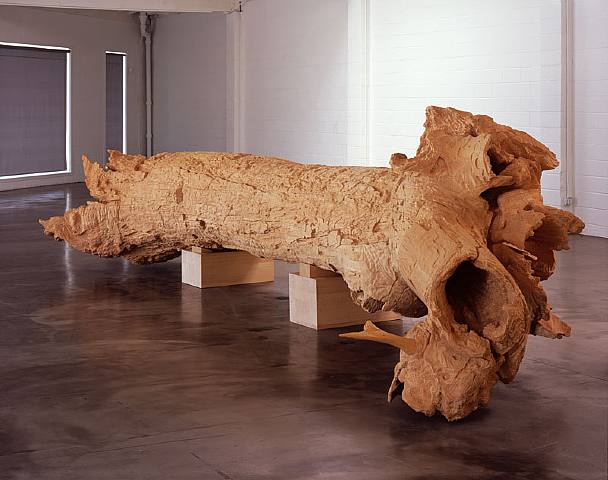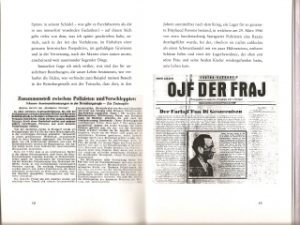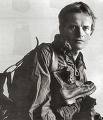Elina Brotherus: Photographs of Sebald’s Corsica
W.G. Sebald’s posthumously published book Campo Santo (Hamish Hamilton, 2003) opens with a series of short pieces he wrote about the trip he took to Corsica around 1990. In the title piece “Campo Santo,” he described one of his days on the island: “My first walk the day after my arrival in Piana took me out on a road that soon begins falling away steeply in terrifying curves, sharp bends and zigzags, leading past almost vertical rocky precipices densely overgrown with green scrub, and so down to the bottom of a ravine opening out into the Bay of Ficajola several hundred meters below.” After a swim in the bay, during which he had a terrifying moment of vertigo, Sebald climbed the steep path back up to the village of Piana where he visited a graveyard, which resulted in what I think is one of his most evocative pieces of writing. As he carefully picked his way through the “rather desolate graveyard” with its “untidy rows” of gravestones, he thought about death and about the complicated, fraught relationship between the dead and the living. For seventeen pages he ruminated about such things as the weeds that had grown up around the graves “to form actual herbariums,” the “oval sepia portraits” of the dead that were embedded in some of the gravestones, the inscriptions and the names on the gravestones, and the history of Corsican burial rites and superstitions surrounding death. It’s obvious to the reader that Sebald had studied this subject with more than just a tourist’s interest.
In 2019, the Finnish photographer Elina Brotherus, one of the finest photographers working today, went to Corsica with “Campo Santo” in mind. There she created a project called “Sebaldiana. Memento mori,” which consists of thirty-six large color photographs and a group of fifty-seven cyanotypes that form her own “Herbarium Pianense.” She has generously given me permission to reproduce eight of the photographs from that series, along with her artist’s statement about the project, which can be read after the photographs.
A number of photographers and artists have created artworks that speak in conversation with Sebald’s books, but Brotherus has done so in an especially rich and complex manner. Brotherus herself always appears in her photographs, giving a strong element of performance to her art. In other projects she dances, acts, and more clearly “performs,” but in “Sebaldiana. Memento Mori,” she strikes more simple, contemplative poses. Her clothing is all black, with the exception of a scarf that matches the color of her bangs. (“Campo Santo” is, after all, largely about death and mourning.) I particularly like the way in which she breaks the fourth wall in several images in this series. We don’t often think of the fourth wall in photography. With the general exception of portrait photography, the subjects in the photography we find in art galleries and museums rarely acknowledge any awareness that they are being photographed or that they will ever be seen by an audience. By staring at us and eyeing us, Brotherus invites her viewers to share more personally in her exploration of Sebald’s Corsica, to imagine becoming participants, not just observers.
Tombeau imaginaire 7 / Imaginary Burial Place 7, by the way, might remind readers of Caspar David Friedrich’s famous painting Wanderer above the Sea of Fog (Der Wanderer über dem Nebelmeer), 1818, the classic German Romantic painting of a man in a dark overcoat standing on a crag overlooking mountaintops wrapped in clouds and fog.

Sebaldiana. Memento mori (2019), by Elina Brotherus
Before I first visited Corsica, I read a collection of text fragments by W. G. Sebald, building blocks for a book about Corsica that was left unfinished at his premature death. Sebald as a writer is highly unusual and difficult to classify: between essayist, novelist and historian, he is scholarly without being dry, poetic without sentimentality, touching on deeply humane topics of post-war Europe with a great sense of historicity. His use of photographs within his books has inspired many artists.
Sebald writes about a certain hotel on the steep red cliffs overlooking the village of Piana on the Western coast of Corsica. His narrator goes to swim from a close-by secluded beach and nearly doesn’t make it back to shore. In the village cemetery he observes the small weeds that grow between the tombstones, nature’s modest ones, unplanted and unplanned, in stark contrast with the looked-after but austere cemetery plantations of Sebald’s native Germany. He then talks about the relatively recent use of cemeteries in Corsica. The old habit was to bury the dead in a beautiful spot in their own land, perhaps under a particular tree, or on the slope behind the house where they could continue to contemplate the view on their ancestral territory. The poorest ones who had no land were simply put in a common grave or in ravine in the mountains.
Sebald became my guide to Corsica. I went to places he mentions: the forest of Aitone and the massif of Bavella, the hotel, the beach and the cemetery in Piana and its backcountry with sculptural rock formations. I was remembering my dead. I looked for places so beautiful that I would like to bury them there, were I Corsican. I collected humble weeds at the cemetery of Piana to make a herbarium.
My father was a hobby photographer and gave me my first camera. When my mother was widowed at the age of 37, she went to art school and had four years of fulfillment. I’m a photographer because of my father, but because of my mother I’m an artist.
My mother died four years later at the age of 41. She was born the same year as Sebald but died 16 years before him. Recently I found some aquarelle paper that she hadn’t had time to use. The sheets had suffered from humidity, were spotted, partly moldy. It is this paper that I used to create my Herbarium Pianense, the cyanotype herbarium of the cemetery. Thus this work became an homage not only to the Island of Beauty and to my favorite writer, but also to my mother, Ulla Brita Brotherus, née Sommar (1944-1985).
All photographs by Elina Brotherus are courtesy of the artist and gb agency, Paris. She gives special thanks to the Centre méditerranéen de la photographie. I urge you to visit her extensive website and view all of her photographic projects.





























